The FBI catches serial killers through extensive criminal profiling. You can capture serial customers the same way by profiling your audiences through insightful consumer personas.
Customer personas are critical because brands no longer own the influence of mass media. The masses are now the media, and they own your brand story.
Enlightened brands have evolved from being promoters of stuff to publishers of meaningful content that empowers customers and moves them to action.
But it only works if you know your audience in what Robert McKee, the legendary screenwriting coach, describes as in a God like way. How else can you possibly connect and invite them into your story?
Audiences include everyone from C-level suits, rank-and-file employees, shareholders, stakeholders and vendors, to prospects, buyers and long-term customers. I consider each audience a “customer,” because you are always selling something you want your audiences to buy into.
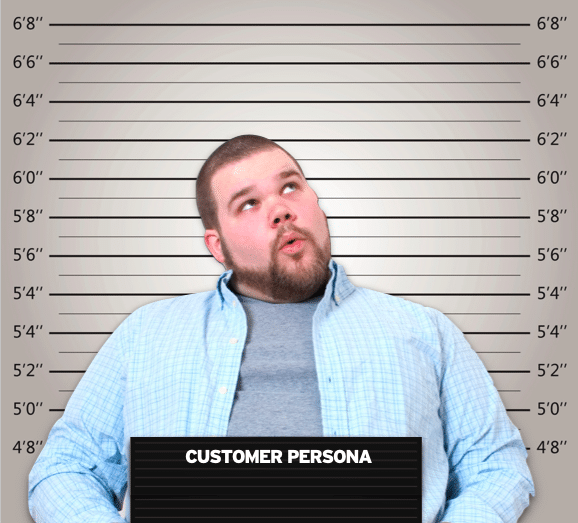
You maybe promoting an internal initiative, sales program, product, service or partner relationship. Regardless, you need to turn whatever you’re promoting into a meaningful and emotional business story that connects with your audience on their terms – from their view of the world – and communicate how your offering will help them on their journey, not yours.
If you don’t craft and tell compelling business and brand stories from your customer’s point-of-view, then you will get lost in the sea of sameness as you compete for attention with old fashioned and undifferentiated features-and-benefit messaging. And you come off looking insensitive, even if you don’t mean to.
Develop empathy, share beliefs, connect values
Last week we explored chapter one of the proven 10-step Story Cycle process, your backstory, to create your brand position statement and set the stage for your brand story strategy. Your position statement is what you stand in terms of features and benefits in the hearts and minds of your customers relative to your competition.
Chapter two of the Story Cycle, Who’s Your Hero, is all about identifying your top three audiences and what they want that you can provide better than anyone else.
One of the biggest “Aha” moments that happen in every one of our brand story strategy workshops is when I say “Spoiler alert: your brand is not the center of the story. Your customer is.” This is a monumental shift in the way most business leaders and brand strategists view the world.
So how do you get there?
The goal is to learn what your audience wants and what is holding them back. Develop empathy for their plight. Share your beliefs on how you can help them get what they want faster and easier than anyone else. Connect your shared values. Empower them, move them to action, and deliver!
There is a simple exercise you can do after you read this post to see if your stories are brand centric or customer centric. I learned it from Ardath Albee of Marketing Interactions during this Business of Story podcast: Who’s Your Hero? Creating Customer Personas for your B2B Marketing. She said to do the pronoun replacement test on your website. Replace “I,” “we,” “our” and “us” with “you” and “your”. When you do this, you will automatically start viewing your brand story from your customer’s perspective, placing them at the center of the journey.
Who are YOUR audiences?
Right now, take a piece of paper and pencil (I know, old school) and jot down your top three audiences in priority order. Who is your most important audience: customers, employees, shareholders…? Who’s your second most important audience, and your third? And then write next to that audience: What do they want?
Here is an example of how we have identified our audiences from our new DIY Brand Story Strategy Workbook that you can download now.
Once you have determined your top three audiences, create customer personas for each. Customer personas are a written characterization of your target audiences capturing the psychographics (what do they think and feel) demographics (how do they live) and what I call “motigraphics” (what motivates them).
What’s cool about the Story Cycle is that you can use this universal story – the same process you’re going through right now if you’re using the DIY Brand Story Strategy Workbook – as an interview guide to research and understand your target audiences. It helps you explore and learn their story so that you know how to connect your brand story to their world.
Here’s a page from the workbook:
Here’s how the #1 audience for the Business of Story looks in the Story Cycle customer persona guide
Customer persona for the Business of Story #1 audience
Backstory: Sam is the founder and CEO of a seven-year-old healthcare technology firm that he started in a co-working space, which has grown to 30 employees now headquartered in his own 10,000 square foot building. Business has been brisk, but as they emerge as a mid-market tech company, Sam knows that the organization, while focusing on expert delivery of their product and customer service, have neglected defining their brand story and aligning it with their employees and customers. Therefore, he has urgency to create a brand narrative to spur the next level of growth for his organization.
Hero: Sam is 37 years old, married and the father of two kids active in sports, with some reluctant piano lessons scheduled in, because the arts are important, too. In fact, he believes coding is a blend of art and science to unlock the potential of users. He is a driven entrepreneur who analyzes every business move, and requires a lot of data and proof in his decision making. He runs four times a week, meditates occasionally, and eats healthy, because he knows it’s good for him and he feels it’s important to model healthy behavior throughout his organization and industry.
Stakes: While focused on outstanding product delivery and fastidious customer service that have led to growing sales, he feels the company is falling short because they have not clarified their brand story. Although an Innovator in some areas of his operations and personal buying habits, Sam is more of a late Early Adopter/Early Majority when investing in professional services for his company. For instance, he has just implemented leadership coaching after considering it for two years.
Disruption: Sam knows international growth means being more professional through all of their advertising, marketing and sales, but everyone in his organization seems to be telling their own story about the brand and its offering. If they are going to continue to double growth every year, he knows that he must unify the organization around one central brand story that they can all buy into and prosper from. And it must be accurately and powerfully reflected through all of their advertising and inbound marketing and sales.
Antagonists: As an analyzer, Sam has difficulty getting out of his own way to make a decision. He needs proof and recommendations from others before he will invest. He is also concerned about the resources required to get his brand story straight, but is starting to appreciate the importance of making the investment of time and money.
Mentor: Results of the epic growth clients have achieved through the Story Cycle process will be critical for Sam’s decision to proceed. The systematic approach of the 10-step process with deliverables in each chapter demonstrating tangible progress is important to his analytical mind. Plus, the combination of Hollywood storytelling coupled with brand marketing plays to his art sensibilities.
Journey: Sam’s awareness of the Business of Story platform comes from a referral. He will adopt the program by first doing a one-on-one session to vet the Story Cycle process, which may mean attending a one-day workshop. He may also use some of the free online storytelling tools to test the quality of the materials. He will then invite his leadership team into the process to develop the overall brand story, because building consensus in his organization is profoundly important to Sam. Appreciation will come following the workshop, and be evangelized once his overall brand story is created.
Victory: Sam will be inspired by the workshop and will look forward to getting his team involved in a process that he found and vetted for the company. We will celebrate the creation of their brand story by rolling it out to the organization with great fanfare. Our goal is to make Sam a vocal ambassador of the Business of Story platform and the Story Cycle process, which he will happily share with his peers and colleagues.
Moral: Sam values a proven, intentional process that is an enchanting combination of art, science and sales – a process that aligns his leadership, brand, employee and customer stories to deliver real results for his organization and people in a timely fashion.
Ritual: We will arm Sam with the story plans and tools to embed storytelling throughout his organization for the growth of his people and enterprise, while also providing the online portal of businessofstory.com for rich content around storytelling.
The customer persona interview guide is found on page 8 of the DIY Brand Story Strategy Workbook.
7 things to remember when crafting audience centered brand stories
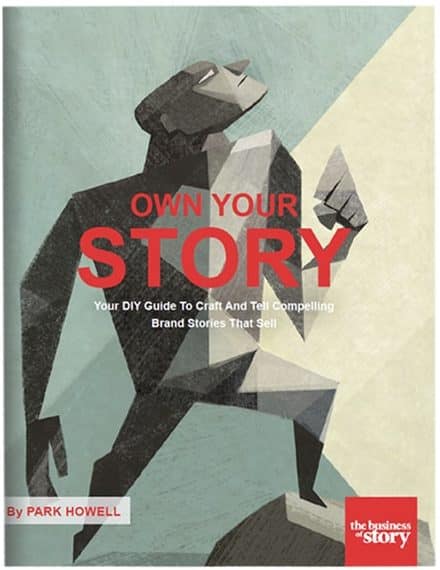 Even if you do nothing else with the Story Cycle than declare your #1 position in the marketplace from chapter one, and identify your top three audiences and what they want relative to what you offer from chapter two, you are already miles ahead of your competition… the lazy ones, not the smart ones. Please remember this:
Even if you do nothing else with the Story Cycle than declare your #1 position in the marketplace from chapter one, and identify your top three audiences and what they want relative to what you offer from chapter two, you are already miles ahead of your competition… the lazy ones, not the smart ones. Please remember this:
- Take the time to research and understand your audiences in a God like way
- Appreciate and empathize with the highs and lows of their journeys
- Share your beliefs on how you can help them within the context of their story
- Connect your shared values
- Empower them with your wisdom and offering
- Move them action
- Fulfill your story promise
Can you do me a favor? Do a quick pronoun check on this post. How often do I use “you” and “your” versus “I,” “we,” “our” and “us”? Did it connect with you and your mission to get your brand story straight?
As you might have guessed by now, I’m hoping to capture a serial customer in you.
Story on!


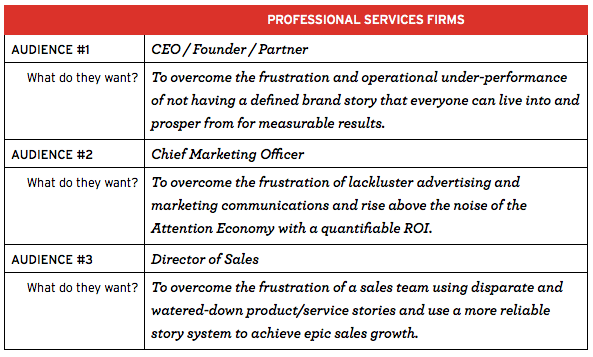
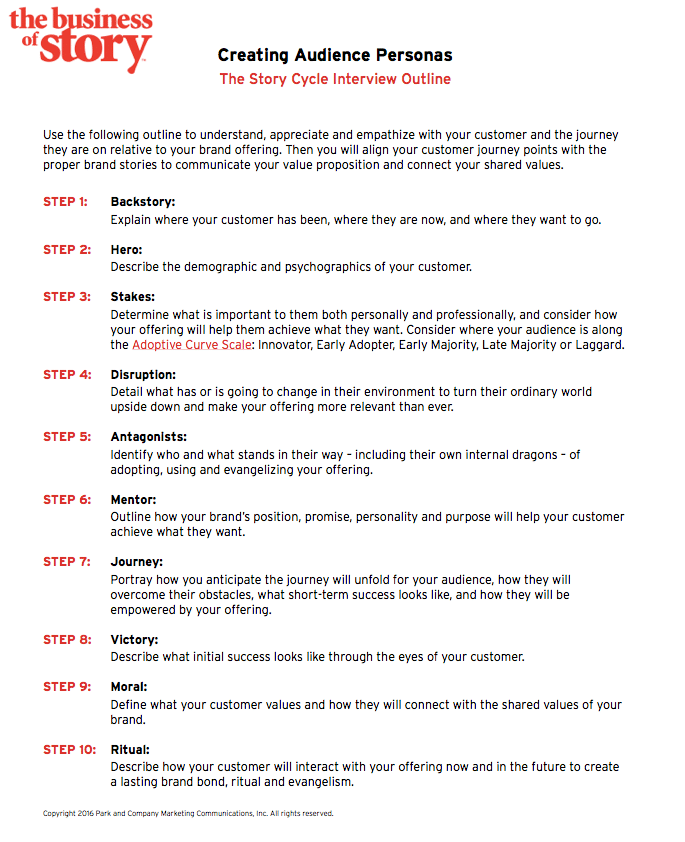

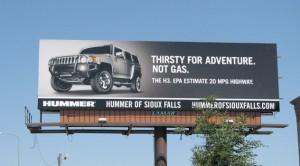


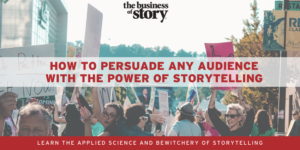





at 8:01 am
[…] chapter 2, Who’s Your Hero?, you created killer customer personas for your professional services firm to place your customer at the center of your brand story. This sets the stage for mapping EXACTLY […]
at 12:54 pm
[…] Step 2, “Who’s Your Hero?”, we identified Podius’ three audiences to create customer personas: debate organizations and associations, adult influences including parents and teachers, and […]
at 10:40 am
[…] you do better than anyone else. In Chapter 2, you identified your top three audiences and learned how to create killer customer personas. In Chapter 3, you determined what’s at stake for both your organization and your […]
at 2:32 pm
[…] statement: the #1 position your brand holds in the marketplace. In chapter two, you identified your top three audiences through customer personas. They are hero’s at the center of your brand story. Then in […]
at 12:09 pm
[…] your top three audiences, the heroes of your brand […]
at 3:42 pm
[…] Identify your top three audiences so you can tell the right story at the right time to the right people […]
at 7:36 am
[…] Identify your top three audiences so you can tell the right story at the right time to the right people […]